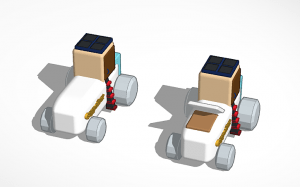Registrations are closed
In the future, to enable astronauts to stay on the Moon for long periods of time, new infrastructures must be developed to overcome important challenges. Such challenges include protection from radiation and meteorites, energy production, the extraction and recycling of water, food production and much more. The Moon Camp Challenge invites students to explore the Moon and decode some of the complexities future astronauts may face.
In Moon Camp Discovery each team’s mission is to 3D design only one component of a Moon Camp using Tinkercad. Teams can choose to design a:
– Lunar lander
– Moon Base
– Lunar rover
– Rocket
– Lunar Orbital Space Station
The design should be adapted to the Moon environment and if possible consider the use of local resources, provide protection and/or living and working facilities for the astronauts.
Moon Camp Discovery is a non-competitive mission for beginners. All teams that submit an entry that complies with the guidelines will receive a participation certificate and their project will be shared on the Moon Camp online platform.
Who can participate?
Participation is open worldwide to students aged up to 19 years old. Moon Camp Discovery is recommended for students aged 6 to 14 years old. Participating students must be supported by a teacher, educator or parent.
Discovery Projects Gallery 2020-2021
Below you can find some of the Moon Camp Discovery projects. For more projects visit the Moon Camp Discovery project gallery.
Team: Andrómeda
Guadalcacín (Cádiz) Spain Category: Lunar rover
External link for Tinkercad 3D design
The vehicle we have designed is a type of space tractor called “Cappetbur”.If you’re wondering why you designed a vehicle, the answer is simple: we were morevisually attracted to it.The characteristics of Cappetbur are:
• It has four wheels and, each of them has an electric motor to supply the energyconsumed by the vehicle.
• On the roof of Cappetbur, there is a large solar plate to maintain the ideal temperaturefor the infrastructure and for the astronauts.
• It has a water extractor at the rear that will allow to extract water (it is believed to existat the poles of the Moon) and analyze its components.
• The vehicle contains a copper box, not very heavy, which will drive the energy (whichit needs) to the engines of the wheels.
• The existence of a mechanism capable of transforming the non-renewable energy ofour vehicle into renewable, and this way, avoid the possible harmful gases that canexpand through the Solar System. Because to be honest, we’re destroying the planetwhere we live on and we don’t want this to happen with our satellite as well.
• It has a variety of cameras that allow the central to see everything around our vehicle.• It has a built-in system that allows to place a flag of the European Union because whenwe are talking about the Moon directly our mind goes to 1969 with Neil Armstrong but,the European countries also worked, work and will work in this mission, so our flagdeserves to be up there next to the USA.Cappetbur will recognize the importance of all countries and while Armstrong said:“That ́s one small step for man, one giant leap for makind” (Un pequeño paso para elhombre, un gran paso para la humanidad), in our opinion more than a step, this is astride to a future where we and our future generations will have more knowledge aboutour satellite.TEAM ANDROMEDA:
















